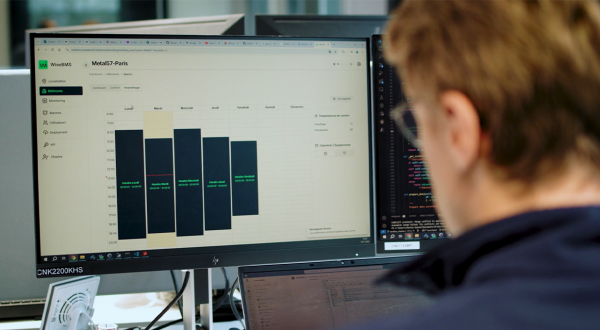Electric mobility getting connected with tertiary buildings
Reading time: 4 min
Increasing numbers of electric vehicles in France are creating significant new demand for charging facilities. In the race to roll out charging stations, tertiary buildings have an opportunity to become vital links in the development of electric mobility.

According to various predictions, by 2035, there will be almost 17 million electric vehicles on France’s roads, dramatically up from 1.1 million at the end of 2022. The revolution in modes of transport and the rise of electric vehicles in France underscore the need for a rapid expansion of charging infrastructure.
According to Avere-France, the national association for the development of electric mobility, there were 1.5 million charging points nationwide in 2023, more than 90% of which were installed either in private households (54%) or in businesses (39%). Publicly accessible charging points in towns and cities and on motorways made up just 7% of the network.
This unequal distribution confirms that charging essentially takes place when vehicles are parked and that drivers rarely interrupt their journeys to recharge their vehicles. Given the inevitable massive increase in demand, therefore, infrastructure in buildings (residential and tertiary) is a priority area for investment.
Huge expansion
In 2023, 650,000 electrical vehicle charging infrastructure (EVCI) points were installed in businesses, compared with 125,667 in 2019. And the requirements of the French Mobility Orientation Law (LOM) will only accelerate this trend. Under this law, company parking areas with more than 10 spaces and for which the planning application was filed after 11 March 2021 must install charging points at one in five parking spaces. At least one space must have an operational charging point at the time construction is completed.
“Electric vehicle charging infrastructure is more than just a big socket – there’s a whole ecosystem of services around it”
If the parking facility contains more than 200 spaces, two must be operational when construction ends. A minimum of 5% of spaces must eventually be similarly equipped.
Separately from the charging infrastructure, since 2022, companies with more than 100 vehicles have been required to order a minimum number of electric vehicles. Companies with fewer than 100 vehicles must, when replacing them, purchase at least 10% electric or plug-in hybrid models (with emissions lower than 60 gCO2/km). These percentages are set to gradually increase: 20% from 1 January 2024, 40% in 2027 and 70% in 2030.
A proliferation of solutions
Attractive prospects in the electric mobility market have fostered a spontaneous proliferation of solutions from startups appearing in the network markets, electricity suppliers, fuel retailers, and vehicle manufacturers.
Pierre Megret, Smart Building Project Manager at VINCI Energies Building Solutions, emphasises that “For building owners and managers, the installation of charging points remains a complex process, given the diverse range of suppliers and solutions available.”
He continues: “Electric vehicle charging infrastructure is more than just a big socket – there’s a whole ecosystem of services around it, from sizing and feasibility studies to supplying the materials and installing and commissioning the equipment for end users, not to mention its monitoring, maintenance and commercial operation.”
The average per-unit cost for an EVCI point is around €5,000. Four-fifths of this tends to be for civil engineering or cabling work. Adapting to the constraints of each building (fire safety, impact resistance and weatherproofing), IT network protection, catering for peak loads and dynamic load balancing on power supply networks, and maintaining equipment in operational condition throughout its life cycle are all key strategic considerations in any EVCI rollout policy.
How is it paid for?
“The project specifications must also cover the monetary implications (charging tariffs, managing payment flows from charging points, billing, etc.),” explains Pierre Megret. “Until 31 December 2024, charging is considered a tax-exempt benefit in kind from an employer. But what happens after that date? We need to plan out our future options now.”
The expansion of EVCI in tertiary buildings will undoubtedly undergo rapid acceleration. Businesses may turn to integrated solutions to guarantee maximum longevity for their equipment.
09/12/2024





